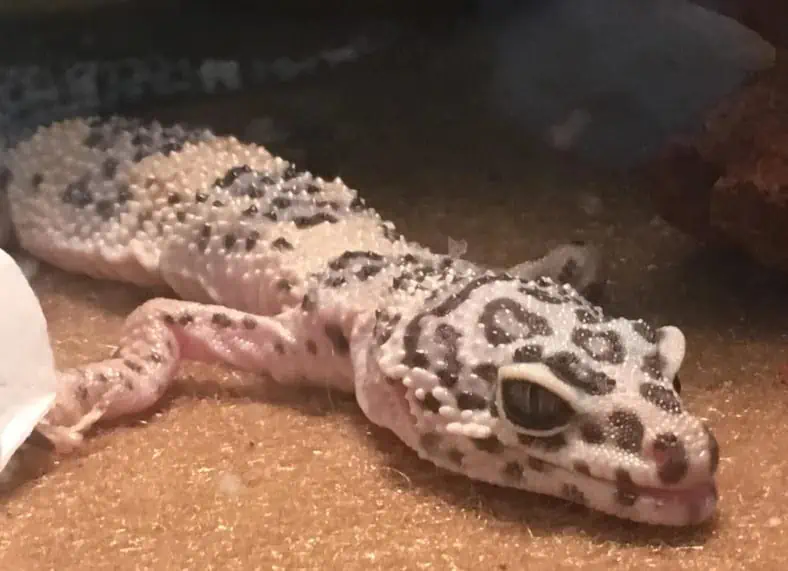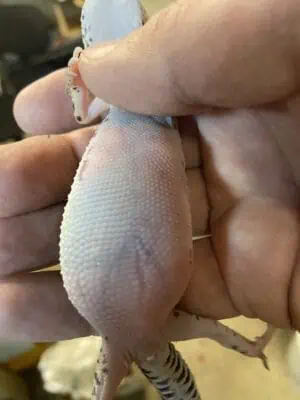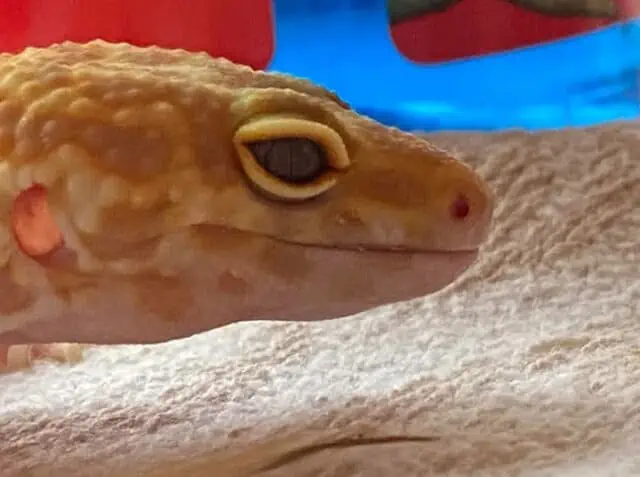When it comes to leopard gecko health, understanding the intricacies of their needs and potential challenges is essential for a long and happy life for your pet. Leopard geckos, with their distinctive patterns and charming demeanor, have become a popular choice among reptile enthusiasts. However, like any pet, they require specific care to ensure they remain healthy and thrive in captivity.
Maintaining Good Health in Your Leopard Gecko
Ensuring your leopard gecko’s health goes beyond mere basics; it’s a holistic approach encompassing diet, hydration, regular check-ups, and understanding potential health risks.
Diet & Nutritional Requirements
Leopard geckos, being true insectivores, have a diet that’s quite different from many other pets. They thrive on a diverse menu of well-fed insects, which forms the cornerstone of their nutritional requirements.
This doesn’t mean just any insect will do. Crickets and mealworms are a staple, but these insects need to be dusted with calcium before they’re fed to your gecko.
This calcium dusting is a vital practice, ensuring your gecko receives the essential minerals necessary for bone health and overall vitality.
Diversifying their diet with appropriate prey items is crucial for their well-being. This includes a variety of feeders like crickets, wax worms, roaches, and fly larvae.
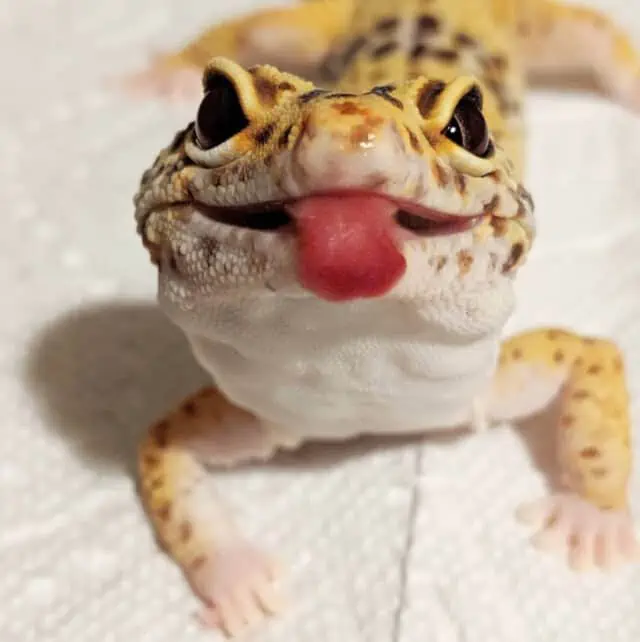
It’s worth noting, however, that the size of the prey and the frequency of calcium dusting should be adjusted according to the age and health of your gecko.
For instance, younger geckos may require more frequent calcium dustings compared to their older counterparts.
Now, beyond just dusting, there’s another essential feeding practice known as ‘gut-loading’. This involves feeding the insects a nutritious diet before they become a meal for your gecko. Think of it as a way of supercharging the prey items with extra nutrients.
Alongside this, providing a shallow bowl filled with calcium powder inside the gecko’s enclosure can be beneficial. Geckos often lap up this powder, further supplementing their intake.
Hydration Needs
Leopard geckos, like all living beings, have specific hydration needs that are paramount for their overall well-being. At the core of these requirements is the need for a consistent source of fresh water.
Providing a shallow dish filled with clean water is not just a simple act; it’s a non-negotiable aspect of gecko care. Not only does this serve as their drinking source, but geckos may occasionally be found voluntarily soaking in this dish.
This behavior is not just for their amusement; it serves both hydrative and exfoliative purposes, aiding them during their shedding periods. It will make getting rid of shed skin easier as well.
Moreover, the presence of a water dish serves a dual purpose as it also contributes to the humidity levels in the enclosure. Humidity is a crucial aspect to consider, particularly for reptiles.
For leopard geckos, the recommended humidity level hovers between 30 to 40 percent. Straying far from this range can lead to health issues, such as problematic shedding or respiratory problems.
To ensure the habitat remains within this ideal humidity bracket, using a hygrometer becomes indispensable. This device will help monitor and maintain the desired humidity level, making certain that your gecko’s environment remains as optimal as possible.
Regular Vet Visits & Tips for Proper Care
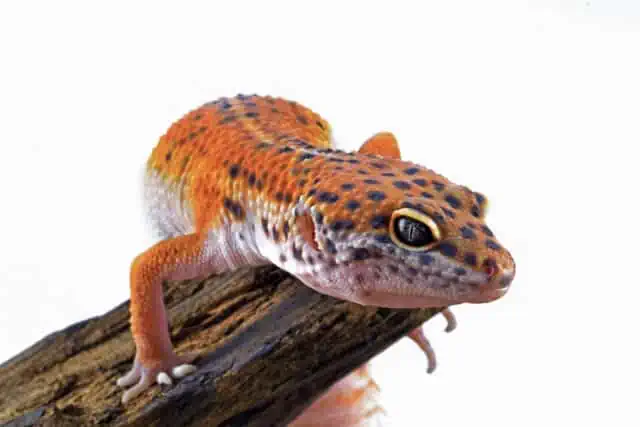
Caring for a leopard gecko goes beyond just providing an appropriate diet and maintaining the right habitat conditions. One of the cornerstone practices for ensuring the longevity and good health of your gecko is scheduling regular vet visits.
Just as humans need periodic check-ups, so do our reptilian friends. An annual check-up, complemented with poop samples, plays a critical role in keeping a keen eye on the overall health of your gecko.
These visits can uncover underlying health issues that might be invisible to even the most observant owners.
Another critical point to bear in mind is that, like all animals, leopard geckos can carry and transmit contagious diseases. The risk might seem minuscule, but it exists nonetheless.
Consequently, it’s of utmost importance to practice thorough hand washing both before and after handling your gecko or interacting with its habitat.
This not only protects you and other household members but also shields your gecko from potential contaminants you might bring in from the outside.
Signs of an Unhealthy Gecko
A healthy leopard gecko is often lively, alert, and responsive. However, like any other animal, they can also face health issues that might not always be apparent to the untrained eye. Recognizing the signs of an unhealthy gecko is crucial for every pet owner to ensure timely intervention and care.
One of the most telltale signs of an unwell gecko is a loss of appetite. While occasional changes in eating habits can be due to various factors like shedding or minor stress, a prolonged loss of appetite is a cause for concern and may be indicative of underlying health issues.
The other extreme is also possible, and a gecko that has become fat would soon be a prime candidate for various diseases.
It’s entirely possible for a leopard gecko to be a carrier of salmonella, and this may impact its health.
Abnormal skin coloration is another sign to be watchful for. Healthy geckos boast vibrant, clear skin. Any cloudiness, unusual spots, or unexpected color changes can be a sign of sickness or stress.
Tail loss, although a natural defense mechanism, can be concerning if it occurs without any apparent threat. A dropped tail will regrow, but it might look different from the original. If your gecko loses its tail without a clear reason, it may be experiencing stress or health complications.
Respiratory issues are also clear indicators of potential health problems. If your gecko is having difficulty breathing, making unusual sounds, or has discharge from its nostrils, these could be signs of a respiratory infection or other related issues.
You might notice signs that are not as clear, such as the Leopard Gecko being upside down (a sign of Enigma syndrome, among others). It’s even possible for leopard geckos to lay eggs without mating, though they will be infertile.
Lastly, impaction is a severe health concern where a gecko’s digestive tract is blocked, often due to ingesting substrate or undigested food. Signs include a swollen belly, lethargy, and a lack of feces. If suspected, prompt medical attention is essential.
Common Health Issues in Leopard Geckos
Leopard geckos, with their distinctive appearance and generally robust health, are popular pets for enthusiasts around the world. However, like all creatures, they are susceptible to specific health challenges. Recognizing these issues early can make a difference in treatment outcomes and the overall well-being of the gecko.
Metabolic Bone Disease (MBD) in Leopard Geckos
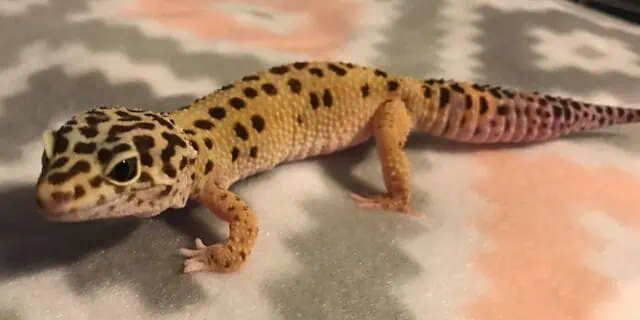
Metabolic Bone Disease, commonly abbreviated as MBD, is a significant health concern for leopard geckos. This disorder arises from an imbalance in the calcium-to-phosphorus ratio in their diet, often exacerbated by a lack of vitamin D3, which is crucial for calcium absorption.
Symptoms of MBD in leopard geckos can range from subtle changes such as weakness and lethargy to more alarming indicators like softening of the jawbone, kinks in the spine, broken bones, and limb deformities. It can lead to the appearance of an underbite, for example.
The foundation of prevention is a calcium-rich diet. It’s imperative for leopard geckos to receive consistent calcium supplementation, typically achieved by dusting their insect prey with calcium powder.
Additionally, ensuring they receive adequate vitamin D3 is equally vital. This can be done either through dietary supplements or specialized reptile lighting that stimulates natural D3 production.
It’s essential to understand the irreversible nature of advanced MBD; once a gecko shows severe symptoms, the damage often cannot be undone. Hence, the emphasis on prevention through the correct diet and supplementation cannot be overstressed.
Cryptosporidiosis in Leopard Geckos
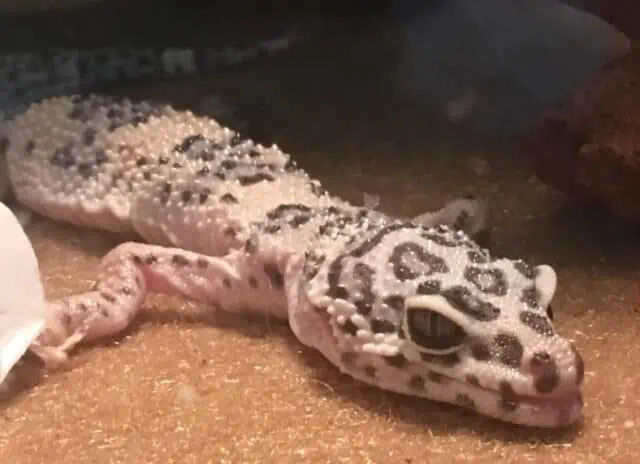
Cryptosporidiosis is a concerning parasitic infection prevalent among leopard geckos. This ailment is caused by the Cryptosporidium parasite, a minuscule but potent intruder that targets the gastrointestinal system of these reptiles.
Infected geckos typically exhibit a range of symptoms, with weight loss and persistent diarrhea being the most common. If left untreated, Cryptosporidiosis can lead to severe complications, which might undermine the overall health and longevity of the gecko.
Prevention is paramount, given the challenges in treating this condition. To minimize the risk of Cryptosporidiosis, leopard gecko owners must adhere to strict hygiene practices. Regularly cleaning and sanitizing the gecko’s habitat is essential, as this reduces the chances of the parasite’s proliferation.
The implementation of routine handwashing before and after handling the gecko and any of its habitat components can also significantly curtail the risk of transmission.
Respiratory Infections
Respiratory infections in leopard geckos are a notable concern, often stemming from bacteria that thrive in environments with excessive humidity and suboptimal temperatures. Such conditions make the gecko more susceptible to these bacterial invasions, which can compromise their respiratory system.
Symptoms manifest in various ways, including pronounced heavy breathing, the presence of bubbles on the nose, a noticeable decline in activity or laziness, unexplained weight loss, and distressing wheezing sounds.
To shield leopard geckos from the risk of respiratory infections, owners must be diligent in managing the habitat’s climate. Maintaining the correct temperature and humidity levels is paramount. This not only ensures a comfortable environment for the gecko but also hinders the growth of harmful bacteria.
Impaction in Leopard Geckos
Impaction is a serious health concern for leopard geckos, primarily caused when they accidentally ingest substrate or consume oversized food items. This unintentional ingestion can lead to a dangerous blockage within their digestive tract, severely compromising their health and overall well-being.
Common signs indicating a gecko may be suffering from impaction include a noticeable lethargy, visible straining when attempting to defecate, and a sudden loss of appetite.
Preventing impaction is paramount, and certain measures can greatly reduce its risk. Owners should be cautious about the substrate they use in the gecko’s enclosure.
Calcium-enriched sands, although popular, can contribute to impaction and should be avoided. Instead, substrates like appropriate-sized gravel can be a safer choice. Furthermore, offering prey of suitable size that aligns with the gecko’s current size can prevent ingestion complications.
If impaction is left unaddressed, it can lead to further severe complications, such as cloacal or colonic prolapse.
Leopard Gecko Stomatitis (Mouth Rot)
Stomatitis, commonly known as mouth rot, is a bacterial infection that can afflict leopard geckos, manifesting in their mouths. Often, this condition arises due to stress, leading to a weakened immune system, making the gecko susceptible to such infections. Various factors can contribute to the onset of stomatitis. Incorrect temperature or humidity levels within the gecko’s enclosure, poor nutrition, or inadequate hygiene practices can all serve as potential triggers for this condition.
The symptoms of stomatitis are evident and should be promptly addressed. Affected geckos may refuse to eat or drink, showing a clear sign of discomfort. Their mouth area might appear red or swollen, indicating inflammation.
Ovarian Cysts
Ovarian cysts are a medical condition that can affect female leopard geckos. These cysts are fluid-filled sacs that develop on one or both ovaries of the gecko. The exact causes are not always clearly defined, but hormonal imbalances, genetic predisposition, or environmental factors may play a role in their development.
Symptoms of ovarian cysts in leopard geckos can vary, but often include abdominal swelling, changes in appetite, weight loss, or lethargy. It’s also possible for the cysts to create complications, such as torsion (twisting of the ovary), rupture, or secondary infections, all of which can be life-threatening if not addressed in a timely manner.
The importance of early detection cannot be stressed enough. Regular check-ups, keen observation, and palpation by experienced handlers or veterinarians can help in identifying ovarian cysts before they become a larger issue.
Treatment options vary based on the size and location of the cysts. In some cases, hormonal treatments might be used to resolve the cysts, while in more severe instances, surgical intervention might be necessary.
Abscesses
Abscesses, particularly massive subcutaneous ones, are an unfortunate health issue that leopard geckos can face. Often located caudal to the periocular tissue, these abscesses manifest as swollen, pus-filled pockets beneath the skin.
These abscesses can cause significant discomfort for the gecko and can become a more serious issue if not treated in a timely manner.
Treatment for abscesses in leopard geckos is a multi-step procedure that should be handled by a veterinary professional. First and foremost, lancing and debridement under anesthesia are recommended. This procedure involves making an incision to drain the abscess and then cleaning out any dead tissue or contaminants.
To ensure that the correct antibiotic treatment is provided, an aerobic and anaerobic culture with sensitivities is typically done. This helps in identifying the bacteria causing the abscess and their resistance pattern.
After the procedure, antibiotics are administered to prevent any further infection. Pain medications and nutritional support play a vital role in ensuring the gecko’s comfort and speedy recovery.
Tail Rot in Leopard Geckos
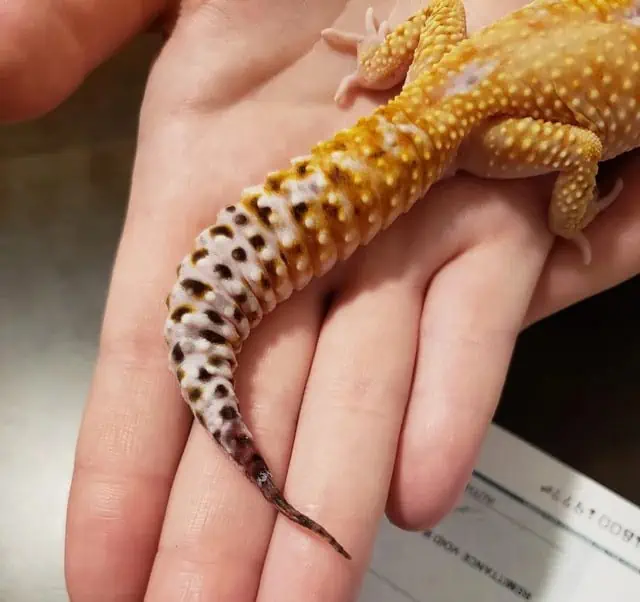
Tail rot is a serious health concern for leopard geckos, which, if left untreated, can lead to significant complications for the animal. The primary causes of tail rot include stuck shed or wounds incurred from fights or other injuries.
When a leopard gecko’s tail doesn’t shed properly or gets injured, it becomes vulnerable to bacterial and fungal infections, leading to tail rot.
The symptoms of this condition are quite noticeable. The tail, especially its tip, becomes dry, discolored, and gradually takes on a blackened appearance. This blackened portion is necrotic, meaning it’s dead tissue and it can spread if not addressed.
Should an owner notice these signs, it’s paramount to consult a veterinarian promptly. Early detection and intervention are key to ensuring the well-being of the gecko.
A veterinarian may recommend the removal of the affected tail tip to prevent the rot from spreading further up the tail. Besides surgical interventions, antibiotics and proper wound care are also vital components of the treatment.
Dysecdysis (Problematic Shedding) in Leopard Geckos
Dysecdysis, often referred to as problematic shedding, is a condition that can affect leopard geckos and is primarily attributed to low humidity levels in their environment.
When a gecko’s habitat doesn’t maintain the correct humidity level, it can result in multiple retained sheds. These retained layers can particularly accumulate around slender areas like toes, leading to restricted blood circulation.
If left unchecked, this restricted blood flow can eventually result in avascular necrosis, a condition where the tissue dies due to a lack of oxygen and nutrients.
To prevent dysecdysis from occurring, it’s crucial for leopard gecko keepers to maintain the right humidity levels. A practical measure to help support successful shedding is by providing a moist hide or nest box within the gecko’s enclosure.
This damp retreat gives the gecko a place to go when it’s time to shed, ensuring that the skin comes off more easily. However, if a gecko does experience dysecdysis, action must be taken promptly. The retained sheds can sometimes be carefully removed after the affected area has been soaked on damp paper towels to soften the old skin.
In severe cases, where the retained sheds have led to complications, affected toes might need to be amputated under the guidance and supervision of a veterinarian.
Parasitic Infections
Leopard geckos, like many reptiles, are susceptible to various parasitic infections. These parasites, which can reside within the gecko’s internal system, can manifest in a variety of symptoms.
Among the more alarming signs are visible bleeding or the presence of blood in the gecko’s stools. Such indications are often a clear sign that the gecko’s internal environment has been compromised by parasitic invaders.
To diagnose and ascertain the type and extent of the parasitic infection, it is crucial for gecko owners to obtain a feces sample and promptly take it to a veterinarian. A thorough analysis of the sample can identify the specific parasites present and determine the best course of treatment.
Based on the diagnosis, the vet will usually prescribe oral medications designed to target and eliminate the parasites. Administering these medications as directed is vital to ensure the gecko’s complete recovery.
Thermal Burns
Thermal burns are an unfortunate and all-too-common injury in captive leopard geckos. Often resulting from heated accessories such as rocks, pads, or overhead lights, these burns can vary from mild to severe and, in extreme cases, can be fatal.
The origin of these burns typically lies in the misconception that, because these creatures thrive in warmer environments, any heat source is beneficial. However, direct or prolonged contact with inadequately controlled heat sources can lead to serious harm.
When a leopard gecko suffers a thermal burn, it’s essential to consult a veterinarian promptly. They can advise on potential treatment options, which may include the application of topical ointments to soothe and heal the affected area or antibiotics to prevent or treat infections that can set in.
However, prevention remains the most effective strategy against thermal burns. Careful habitat setup, including monitoring and regulating all heat sources, is paramount. Properly positioning and shielding heat elements, using thermostats, and routinely checking the temperatures within the habitat can ensure a safe and comfortable environment for the gecko, mitigating the risk of such injuries.
Eye Problems in Leopard Geckos
Leopard geckos, like many reptiles, can experience a range of eye problems that can compromise their overall health and well-being.
Among the most common are ulcers and bacterial infections, often stemming from solid debris trapped under their eyelids. Such debris, be it substrate particles or other foreign bodies, can cause irritation, inflammation, and even lead to infections if not promptly addressed.
When dealing with these eye issues, it’s crucial to ensure proper treatment. Often, this involves delicately removing the offending debris, flushing out the eyes with a sterile saline solution, and subsequently administering both systemic and ocular antibiotics to combat any infections. Early intervention and appropriate treatment can make all the difference in the outcome, and blindness in leos can usually be avoided.
However, not all eye problems are related to infections. A healthy gecko’s eyes should be clear, bright, and free from discharge or signs of irritation.
Sunken eyes, on the other hand, can be indicative of dehydration, signaling a potential issue with the gecko’s habitat or health.

